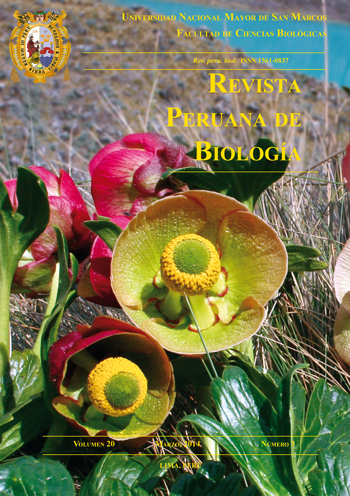Reproductive parameters of Hypsiboas punctatus(Schneider 1799) (Anura: Hylidae) in the south limit of its distribution area
DOI:
https://doi.org/10.15381/rpb.v20i3.5243Keywords:
Hypsiboas punctatus, reproductive parameters, life history traits variability.Abstract
Hypsiboas punctatus(Schneider 1799) has a wide distribution in South America, throughout a latitudinal and environmental gradient (tropical/temperate), thus, supporting significantly different pressures among populations. Until now, only tropical populations’ reproductive parameters have been recorded. Then, our goal was to study reproductive parameters on a population inhabiting a temperate climate region to evaluate differences with those inhabiting tropical regions. Studied frogs were smaller than those from tropical regions. There was no correlation between weight and size of males and their testicles volume. Conversely, females’ weight and size was positively correlated to their fertility. Fat bodies were developed in males but absent in females. When compared with other studies, our results showed the variability in reproductive parameters of H. punctatusbetween tropical and temperate regions. This variability could be the result of phenotypic plasticity and/or genetic differentiation between distant populations. This variability may be one of the keys that allow H. punctatusto thrive in diverse ecosystems with different characteristics and environmental pressures.Downloads
Downloads
Published
Issue
Section
License
Copyright (c) 2013 Carolina E. Antoniazzi, Romina Ghirardi, Javier A. López, Andrea P. Armando

This work is licensed under a Creative Commons Attribution-NonCommercial-ShareAlike 4.0 International License.
AUTHORS RETAIN THEIR RIGHTS:
a. Authors retain their trade mark rights and patent, and also on any process or procedure described in the article.
b. Authors retain their right to share, copy, distribute, perform and publicly communicate their article (eg, to place their article in an institutional repository or publish it in a book), with an acknowledgment of its initial publication in the Revista Peruana de Biologia.
c. Authors retain theirs right to make a subsequent publication of their work, to use the article or any part thereof (eg a compilation of his papers, lecture notes, thesis, or a book), always indicating its initial publication in the Revista Peruana de Biologia (the originator of the work, journal, volume, number and date).


















